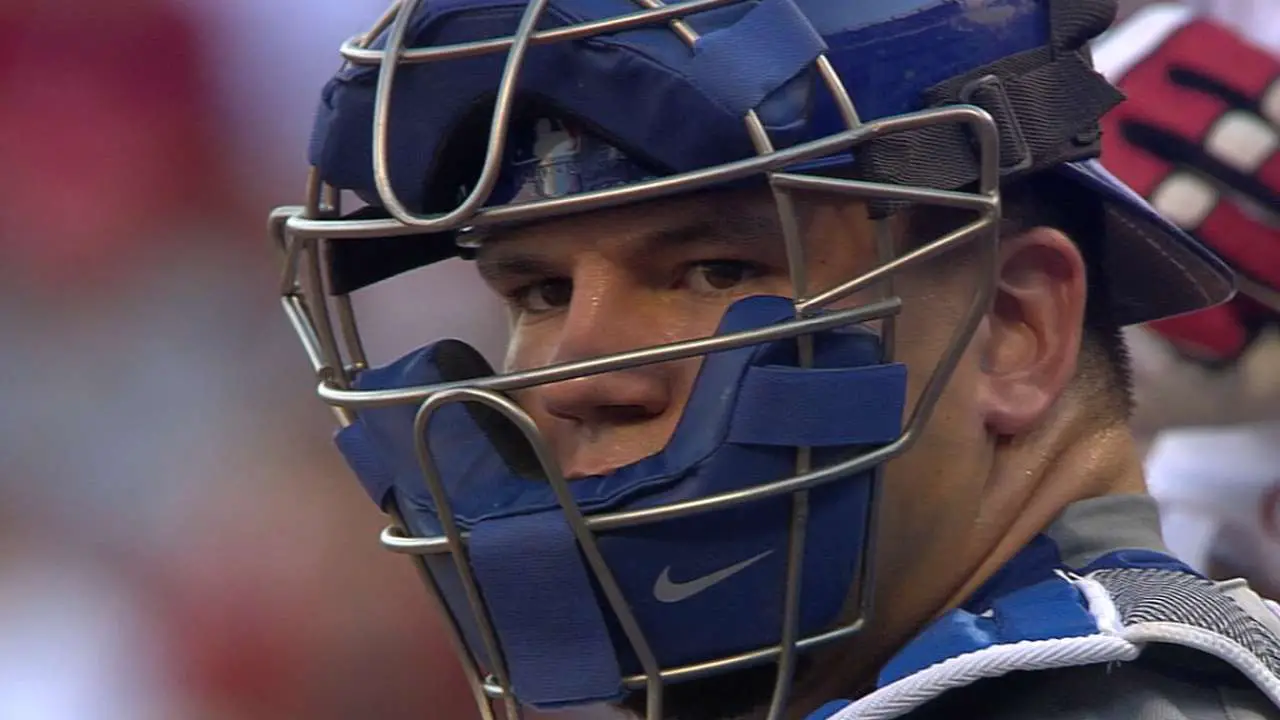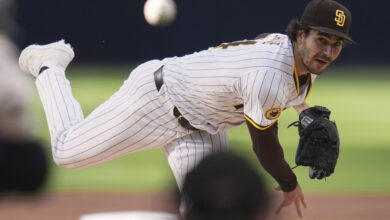
So Who’s Kyle Schwarber Going to Catch?
Despite the presence of two veterans ahead of him on the depth chart and a stud prospect working his way toward Wrigley, Kyle Schwarber is still seeing work as a catcher, at least on a part-time basis. He’s getting reps behind the plate in Mesa and figures to be in some sort of a rotation there once the Cubs head north for the regular season. I had theorized back in late October that he’d probably catch a game every 10 days or so, if for no other reason than to give Miguel Montero even more of a break than what David Ross already will as Jon Lester’s caddy. Of course, this also serves to get more at-bats for Chris Coghlan and keeps both Schwarber and the Cubs content with the idea that he still could be a catcher.
The Cubs figure to have a pretty solid rotation, but that doesn’t mean they want or can afford to give away any advantages created by Montero’s framing or Ross’s arm, not to mention the superior game-calling talents those two possess. And you can’t just throw Schwarber out there all willy-nilly, as there’s more to the position than just crouching behind the plate and providing a target. As such, there had been some scuttlebutt that Schwarber could be paired with a particular pitcher, much the same way Ross is linked to Lester. Joe Maddon lent a bit of credence to that school of thought, admitting Sunday that the club has considered it. The manager was also quick to qualify the idea by saying that many different factors would be at play.
It’s no secret that the Cubs will be hewing a bit more closely to the pitching models employed by the Rays and Royals (I’m not a fan of the author, but the info in the article is nice), among others, which is to say that they’ll be looking to monitor and limit starters’ innings this season. That said, tying War Bear to a particular starter as a way to sort of give him training wheels could be complicated by pulling said pitcher early and moving to a reliever with a different skillset and repertoire. They could always move Schwarber out to left and bring Montero or Ross in to catch in those situations, but that’s really getting into some speculative territory that I don’t care to traverse right now. For this particular exercise, I’d prefer to simplify things as much as possible in an effort to determine which starting pitcher would provide the best fit for a young catcher who may or may not have a future at the position.
For obvious reasons, we can go ahead and remove Lester from contention, which helps to distill things at least a little bit. And while many still see the back end of the rotation as an open competition, I’m going to go ahead and pencil Jason Hammel and Kyle Hendricks into those roles. Now we’re looking at four pitchers to whom Schwarber could be handcuffed, though it’s pretty unlikely he’ll be working with Arrieta. Still, the reigning Cy Young did mention last season that he liked throwing to Schwarber, so I won’t dismiss the pairing out of hand. But how, then, do we figure out which starter would serve as the most suitable battery-mate?
My initial thoughts are that you’d want to find a guy who throws strikes and is thus less beholden to framing, but who’s not a big strikeout guy. If that sounds odd to you, consider that getting swings and misses — or called strikes, for that matter — is not always, or even often, about throwing in the actual strike zone. The more a pitcher plays around the corners of the zone, the more he’s going to need a crafty framer. And the more electric a pitcher’s stuff, the more often his catcher will need to employ solid blocking skills. So to find which starter represents the best match for Schwarber, I took at a look at various metrics that measure a pitcher’s performance in terms of how he works in and around the zone.
Let’s take a look at some numbers.
Many of you are probably familiar with these categories already, or are able to discern their meanings relatively quickly, but I’ll give a brief primer just in case. Zone Rate is how many of a pitcher’s offerings are considered strikes, Swing Rate is how often a hitter swings at said offerings, and Z and O Swing illustrate how many of those swings come on pitches in and out of the strike zone. If that doesn’t do it for you, I’ll also be including heat maps (using data from the last three seasons) in order that you can better visualize exactly what these numbers mean in terms of where these guys locate. Finally, I’ll gladly provide further explanation in the comments should you seek further instruction.
I had left Jake Arrieta in the conversation, but conventional wisdom and the numbers above tell us that we can pretty much rule him right out. He’s easily out front when it comes to innings per start, but he isn’t exactly a pound-the-zone kind of guy. And when you see that his O-swing and Swinging-Strike rates are the highest of the bunch, you know that Schwarber isn’t the best guy to have catching him. And if you aren’t big on numbers, just think about a raw, untested backstop trying to field the filth that is that slider/cutter. Could get ugly.
Interestingly enough, Jason Hammel is right behind Arrieta when it comes to getting strikeouts and swinging strikes. That, coupled with his relative inability to go deep into games, makes him an unlikely pairing as well. It’s possible that he comes back strong in 2016 and erases the worries that surfaced post-injury last season, but a Schwarber/Hammel battery is imperfect at best. That leaves us with just two options: Lackey and Hendricks.
Kyle Hendricks generates the fewest swings of this group, largely based on his propensity to nibble around the edges of the zone. Not surprisingly, we can see from his Zone Rate that he’s also the least effective of the group in question when it comes to throwing strikes. Hendricks has shown flashes of near dominance, but he’s also looked very hittable at times. In short, he’s been an inconsistent performer whose style may require the firm but gentle hands of masseuse behind the plate. What’s more — and perhaps I’m operating under some anachronistic assumptions here — it’s always struck me that veterans with solid reputations tend to get the benefit of the doubt with umpires. That said, I can’t imagine either member of a Hendricks/Schwarber duo getting much help from blue.
So now we’re down to only John Lackey. I know some of you are envisioning him yelling at his catcher or glaring at his defenders, or worse, and thinking that matching him with a project like War Bear might not be the best idea. But look at the numbers and check the heat map and see what you think. Lackey stays in the zone more often and induces more swings than his teammates, but he’s clearly less reliant on strikeouts. He’s not throwing high-90’s fastballs or darting sliders that make you question the laws of physics. In short, we’re not talking about a guy who’s out there just eating hitters alive. Lackey has been around the block and back, he’s made detours through dark alleys and he knows where all the bodies are buried. I guess what I’m trying to say is that the guy has seen it all and doesn’t necessarily need to rely on his catcher to call the game and frame him, er, frame his pitches.
Yes, Lackey comes across as a crusty dude with a short fuse, but he knows what he’s doing out there and could be a nice foil for a young catcher still learning the ropes. Does that mean Schwarber should be acting as his accomplice every fifth day though? Not so fast, my friends.
I stand by what I wrote a few months back, which is that the former Hoosier should be used judiciously behind the plate. That said, I think we could see Schwarber working with Lackey maybe every other time through the rotation, then catching Hendricks and Hammel maybe every third or fourth time through. This kind of strategy would accomplish all the playing-time goals mentioned earlier and would also allow Schwarber to hone his skills as a receiver. I’m not trying to cop out here by basically saying the sophomore should work with most of the rotation, as I do think Lackey should be the primary partner. But it’d be foolish, in my opinion anyway, to have two predetermined battery combos every time through.
Not one for stagnation or staid routines, I can’t imagine Joe Maddon taking that route anyway. I’d envision Maddon and his staff looking at all the variables, including the opposing pitcher and lineup, when determining with whom their young catcher will work. If, for instance, the Cubs are facing a top-of-the-rotation lefty, Schwarber would probably be better off in left field or the bench. Why have him trying to work on both his catching and hitting lefties at the same time? But if the Cubs have a matchup with the Reds or Brewers, they’ll be able to afford a little more leeway to put Schwarber behind the plate. Again, I’m not here to examine the myriad factors involved in these decisions, though it’s impossible not to give them at least a small chin-raise of acknowledgement.
Spring Training should give the Cubs a chance to see how the kid works with each of the guys named here, along with the various members of the relief corps. And Schwarber’s going to get some more reps if only to spell the two veterans, neither of whom needs to do much more than knock a little rust off. Once things move to Chicago, however, the decisions on which batteries to use will be carrying significantly more weight. Everything I’m seeing points to Lackey, warts and all, being the guy to help bring Schwarber along, but I’m really interested to see how the coaching staff feels and how this will play out over the next several weeks and months.






